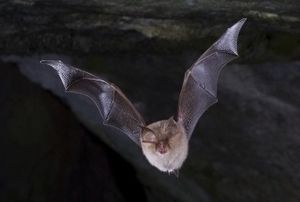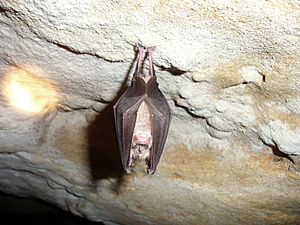Wigpool Ironstone Mine facts for kids
| Site of Special Scientific Interest | |
| Area of Search | Gloucestershire |
|---|---|
| Coordinates | 51°52′31″N 2°30′12″W / 51.875241°N 2.503272°W |
| Interest | Biological |
| Area | 34.88 hectare |
| Notification | 1998 |
Wigpool Ironstone Mine is a very special place in Gloucestershire, England. It covers about 35 hectares, which is like 70 football fields! In 1998, this area was named a Site of Special Scientific Interest (SSSI). This means it's a really important spot for nature, especially for bats.
Contents
Why Wigpool Ironstone Mine is Special for Bats
Wigpool Ironstone Mine is part of a group of important natural sites in the Forest of Dean and Wye Valley. These areas are super important because they provide homes for two types of bats: the Lesser horseshoe bat and the Greater horseshoe bat. These bats are very special and need protection, which makes these sites important across Europe.
Bat Homes: Breeding and Hibernation Sites
The Forest of Dean and Wye Valley have lots of leafy forests and quiet valleys. These are perfect places for bats to find food. The old mines and underground tunnels provide safe places for bats to live, raise their young, and sleep through the winter (this is called hibernation).
There are many old iron mines in the Forest of Dean. These mines have created a network of underground spaces. These spaces are perfect for bats to hibernate when it gets cold.
Other Important Bat Sites Nearby
Wigpool Ironstone Mine is one of several SSSIs in Gloucestershire that help these bats. Other places where bats breed include Blaisdon Hall, Caerwood and Ashberry Goose House, Dean Hall Coach House & Cellar, and Sylvan House Barn.
Other places where bats hibernate include Buckshraft Mine & Bradley Hill Railway Tunnel, Devil's Chapel Scowles, Old Bow and Old Ham Mines, and Westbury Brook Ironstone Mine. All these sites work together to protect the bats.
Protecting the Bats at Wigpool Mine
Wigpool Ironstone Mine is known as a hibernation spot for both Lesser and Greater Horseshoe bats. To keep the bats safe, the entrances to the mine are protected with gates and grilles. This stops people from disturbing the bats.
Experts from the Forest of Dean Caving Conservation and Access Group check these sites regularly. They make sure the bats are doing well. The bats continue to use Wigpool Ironstone Mine, which is great news for these important creatures.
Nearby Nature: Wigpool Nature Reserve
Right next to Wigpool Ironstone Mine, on its western side, is the Wigpool nature reserve. This area also helps protect the local wildlife and natural environment.



